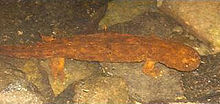Cryptobranchoidea: Difference between revisions
m Undid revision 1097093373 by AD7UPLGW6N (talk); not a species |
No edit summary |
||
| (2 intermediate revisions by 2 users not shown) | |||
| Line 15: | Line 15: | ||
*{{extinct}}''[[Nesovtriton]]''? |
*{{extinct}}''[[Nesovtriton]]''? |
||
*{{extinct}}''[[Iridotriton]]''? |
*{{extinct}}''[[Iridotriton]]''? |
||
*{{extinct}}''[[Kiyatriton]]? |
*{{extinct}}''[[Kiyatriton]]''? |
||
*{{extinct}}''[[Laccotriton]]'' |
*{{extinct}}''[[Laccotriton]]'' |
||
*{{extinct}}''[[Sinerpeton]]'' |
*{{extinct}}''[[Sinerpeton]]'' |
||
| Line 28: | Line 28: | ||
}} |
}} |
||
The '''Cryptobranchoidea''' are a [[suborder]] of [[salamanders]] found in Asia, European Russia, and the United States. They are known as '''primitive salamanders''', in contrast to [[Salamandroidea]], the '''advanced salamanders'''.<ref>{{cite web|url=http://animaldiversity.ummz.umich.edu/site/accounts/information/Cryptobranchidae.html|title=ADW:Family Cryptobranchidae: giant salamanders and hellbenders|first=Heather|last=Heying}}</ref> It has two living subdivisions, [[Cryptobranchidae]] |
The '''Cryptobranchoidea''' are a [[suborder]] of [[salamanders]] found in Asia, European Russia, and the United States. They are known as '''primitive salamanders''', in contrast to [[Salamandroidea]], the '''advanced salamanders'''.<ref>{{cite web|url=http://animaldiversity.ummz.umich.edu/site/accounts/information/Cryptobranchidae.html|title=ADW:Family Cryptobranchidae: giant salamanders and hellbenders|first=Heather|last=Heying}}</ref> It has two living subdivisions, [[Cryptobranchidae]] ([[Andrias|Asian giant salamanders]] and [[Hellbender|hellbenders]]), and [[Hynobiidae]], commonly known as Asian salamanders. |
||
Giant salamanders are obligate paedomorphs with partial metamorphosis,<ref>[https://www.pnas.org/doi/full/10.1073/pnas.1703877114 Evidence for complex life cycle constraints on salamander body form diversification]</ref> but Asiatic salamander goes through a full metamorphosis. The only known exceptions are the [[Longdong stream salamander]], which has been documented as facultatively neotenic, and the [[Ezo salamander]], where a now assumed extinct population from Lake Kuttarush in Hokkaido had neotenic traits like gills in adults.<ref>[https://www.ncbi.nlm.nih.gov/pmc/articles/PMC5878659/ Osteology of Batrachuperus londongensis (Urodela, Hynobiidae): study of bony anatomy of a facultatively neotenic salamander from Mount Emei, Sichuan Province, China]</ref> |
|||
Some species of the fully aquatic family [[Cryptobranchidae]] are known as '''giant salamanders''' due to their large size. |
|||
The oldest members of the group are known from the [[Middle Jurassic]] ([[Bathonian]]) aged [[Yanliao Biota]] of China.<ref name=":0">{{Cite journal| |
The oldest members of the group are known from the [[Middle Jurassic]] ([[Bathonian]]) aged [[Yanliao Biota]] of China.<ref name=":0">{{Cite journal|last1=Jia|first1=Jia|last2=Anderson|first2=Jason S.|last3=Gao|first3=Ke-Qin|date=2021-07-23|title=Middle Jurassic stem hynobiids from China shed light on the evolution of basal salamanders|journal=iScience|language=English|volume=24|issue=7|page=102744 |doi=10.1016/j.isci.2021.102744|pmid=34278256 |pmc=8264161 |issn=2589-0042|doi-access=free}}</ref> |
||
==Taxonomy== |
==Taxonomy== |
||
This suborder contains only two families at present. All other members are extinct and are only known as fossils. |
This suborder contains only two families at present. All other members are extinct and are only known as fossils. |
||
*{{extinct}}''[[Chunerpeton]]'' [[Haifanggou Formation]], China, Middle Jurassic ([[Bathonian]]) ([[Neoteny|neotenic]], has alternatively been recovered outside of Cryptobranchoidea)<ref>{{Cite journal|date=2020-12-08|title=Revision of Chunerpeton tianyiense (Lissamphibia, Caudata): Is it a cryptobranchid salamander? |
*{{extinct}}''[[Chunerpeton]]'' [[Haifanggou Formation]], China, Middle Jurassic ([[Bathonian]]) ([[Neoteny|neotenic]], has alternatively been recovered outside of Cryptobranchoidea)<ref>{{Cite journal|date=2020-12-08|title=Revision of Chunerpeton tianyiense (Lissamphibia, Caudata): Is it a cryptobranchid salamander?|journal=Palaeoworld|language=en|doi=10.1016/j.palwor.2020.12.001|issn=1871-174X|doi-access=free|last1=Rong |first1=Yu-Fen |last2=Vasilyan |first2=Davit |last3=Dong |first3=Li-Ping |last4=Wang |first4=Yuan |volume=30 |issue=4 |pages=708–723 }}</ref> |
||
*{{extinct}}''[[Jeholotriton]]'' Haifanggou Formation, China, Middle Jurassic (Bathonian) (neotenic) |
*{{extinct}}''[[Jeholotriton]]'' Haifanggou Formation, China, Middle Jurassic (Bathonian) (neotenic) |
||
*{{extinct}}''[[Pangerpeton]]'' Haifanggou Formation, China, Middle Jurassic (Bathonian) |
*{{extinct}}''[[Pangerpeton]]'' Haifanggou Formation, China, Middle Jurassic (Bathonian) |
||
Latest revision as of 13:50, 3 May 2024
| Cryptobranchoidea | |
|---|---|

| |
| Cryptobranchus alleganiensis | |

| |
| Hynobius fossigenus | |
| Scientific classification | |
| Domain: | Eukaryota |
| Kingdom: | Animalia |
| Phylum: | Chordata |
| Class: | Amphibia |
| Order: | Urodela |
| Suborder: | Cryptobranchoidea Dunn, 1922 |
| Subgroups | |
| |
The Cryptobranchoidea are a suborder of salamanders found in Asia, European Russia, and the United States. They are known as primitive salamanders, in contrast to Salamandroidea, the advanced salamanders.[1] It has two living subdivisions, Cryptobranchidae (Asian giant salamanders and hellbenders), and Hynobiidae, commonly known as Asian salamanders.
Giant salamanders are obligate paedomorphs with partial metamorphosis,[2] but Asiatic salamander goes through a full metamorphosis. The only known exceptions are the Longdong stream salamander, which has been documented as facultatively neotenic, and the Ezo salamander, where a now assumed extinct population from Lake Kuttarush in Hokkaido had neotenic traits like gills in adults.[3]
The oldest members of the group are known from the Middle Jurassic (Bathonian) aged Yanliao Biota of China.[4]
Taxonomy[edit]
This suborder contains only two families at present. All other members are extinct and are only known as fossils.
- †Chunerpeton Haifanggou Formation, China, Middle Jurassic (Bathonian) (neotenic, has alternatively been recovered outside of Cryptobranchoidea)[5]
- †Jeholotriton Haifanggou Formation, China, Middle Jurassic (Bathonian) (neotenic)
- †Pangerpeton Haifanggou Formation, China, Middle Jurassic (Bathonian)
- †Nesovtriton Bissekty Formation, Uzbekistan, Late Cretaceous (Turonian)
- †Iridotriton Morrison Formation, United States, Late Jurassic (Tithonian)
- †Kiyatriton Itat Formation, Russia, Middle Jurassic (Bathonian) Ilek Formation, Russia, Early Cretaceous (Barremian-Aptian) (Presumed to be a cryptobranchoid)
- †Laccotriton Fengshan fossil bed, China, Late Jurassic (Tithonian)
- †Sinerpeton Fengshan fossil bed, China, Late Jurassic (Tithonian)
- Cryptobranchidae (Late Cretaceous-Recent)
- Panhynobia[4]
- †Liaoxitriton Jiufotang Formation, China, Early Cretaceous (Aptian)
- †Linglongtriton Tiaojishan Formation, China, Late Jurassic (Oxfordian)
- †Neimengtriton Haifanggou Formation, China, Middle Jurassic (Bathonian)
- †Regalerpeton Dabeigou Formation, China, Early Cretaceous (Hauterivian)
- †Nuominerpeton Longjiang Formation, China, Early Cretaceous (Aptian)
- Hynobiidae (Miocene-Recent)
References[edit]
- ^ Heying, Heather. "ADW:Family Cryptobranchidae: giant salamanders and hellbenders".
- ^ Evidence for complex life cycle constraints on salamander body form diversification
- ^ Osteology of Batrachuperus londongensis (Urodela, Hynobiidae): study of bony anatomy of a facultatively neotenic salamander from Mount Emei, Sichuan Province, China
- ^ a b Jia, Jia; Anderson, Jason S.; Gao, Ke-Qin (2021-07-23). "Middle Jurassic stem hynobiids from China shed light on the evolution of basal salamanders". iScience. 24 (7): 102744. doi:10.1016/j.isci.2021.102744. ISSN 2589-0042. PMC 8264161. PMID 34278256.
- ^ Rong, Yu-Fen; Vasilyan, Davit; Dong, Li-Ping; Wang, Yuan (2020-12-08). "Revision of Chunerpeton tianyiense (Lissamphibia, Caudata): Is it a cryptobranchid salamander?". Palaeoworld. 30 (4): 708–723. doi:10.1016/j.palwor.2020.12.001. ISSN 1871-174X.

